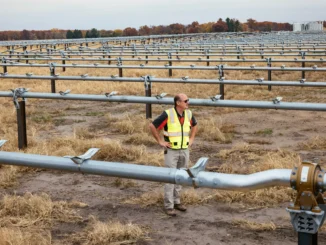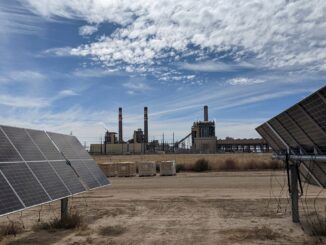
Northern Indiana Public Service Co. is planning to build a 400-megawatt natural gas-fired power plant that critics say is unnecessary, out of step with clean energy goals, and happening outside the usual planning process.
In September, the utility asked the Indiana Utility Regulatory Commission for a needed certificate of public convenience and necessity to build the $643 million peaker plant on the site of the retiring R.M. Schahfer coal plant in Jasper County in central Indiana.
The utility, known as NIPSCO, says it needs the plant to provide power during times of high demand, since it will be phasing out coal by 2028 and transitioning to renewables.
“Energy from renewable resources does not follow the load,” David Walter, NIPSCO vice president for power delivery, testified before the commission. “In order to have generation available when the load is there but sufficient energy from renewable resources is not, it is critical to have sufficient fast-starting, quick-ramping dispatchable generation,” meaning the natural gas plant.
NIPSCO also says the plant could be converted to run on natural gas blended with hydrogen — a fuel being pushed by the U.S. Department of Energy, including with the recent funding of regional hydrogen hubs.
Groups with intervenor status — including Citizens Action Coalition and the Industrial Group of NIPSCO customers — are in the process of filing testimony about the proposed gas plant, due Dec. 12.
Just Transition Northwest Indiana legislative director Susan Thomas said the organization “is actively opposing this build-out of what will most likely be only an occasional-use facility that either prolongs the use of fossil fuels for another 50 years or will be rendered obsolete due to more stringent climate regulations in the future.”
Currently, NIPSCO’s generation mix is 43% coal, 26% natural gas, 17% solar and 15% wind. In its 2018 integrated resource plan, NIPSCO proposed to close all its coal plants by 2028, and keep running its existing Sugar Creek natural gas plant.
NIPSCO told the commission in recent testimony that by 2028, it expects to get 31% of its capacity from natural gas-fired power, 13% from wind and 55% from solar plus storage.
NIPSCO’s 2021 integrated resource plan called for 300 MW of natural gas. In its September filing, NIPSCO said that the proposal for a 400-megawatt gas plant is based on a recent analysis including “market shifts” since 2021, like rule changes in the MISO wholesale market and passage of the Inflation Reduction Act.
“They’re backsliding off their 2018 commitment,” is how Thomas sees it.
NIPSCO had originally planned to retire two units of the Schahfer coal plant in 2023, but had to extend to 2025 because of delays in getting planned solar online, it told the commission. Two more units at Schahfer are scheduled to close by 2028, and existing gas-fired peaking units at that site are scheduled to close in 2026. NIPSCO’s Michigan City coal plant is scheduled to close by 2026.
Citizens Action Coalition program director Ben Inskeep noted that NIPSCO has another integrated resource plan due next fall. He said that process would be the appropriate place to explore and explain the need for new gas peaker capacity, offering more chances for public scrutiny and input.
“We’ve had great dialogue with them in the [integrated resource planning] stakeholder process in the past; they’ve been receptive to feedback,” Inskeep said. “One of the sad parts about this proceeding is it’s a step backwards in the process with them; it kind of breaks trust when you have an understanding about how things will operate and you’ve been successful, and then they’ve gone outside the process to come up with a different answer.”
Walter told the commission that NIPSCO could not wait to launch the gas plant request during the 2024 integrated resource planning process, since that would delay plant construction “until late 2027 at the earliest,” while the company said it needs the capacity by 2026.
Advocates say that rather than constructing a natural gas plant to fill gaps in renewable generation, NIPSCO could buy power from the MISO wholesale market, while also reducing energy needs through demand response and energy efficiency programs.
Inskeep said the math behind the gas plant proposal is especially tricky given that it depends on both wholesale power prices in the future, and natural gas prices, for NIPSCO to supply its own plant. Natural gas prices have been particularly volatile over time, severely impacted by things like the fracking boom and the Ukraine-Russia war.
“They’re saying that additional capacity will give them the ability to basically buy less electricity from the MISO wholesale power market, an insurance mechanism so they’re not buying wholesale energy during the few hours of the year when the solar and wind they are building might not be operating,” Inskeep said. “Whether this resource meets the cost-benefit analysis is unclear to me. Is it really going to make the gas plant worth it, even if you don’t take into consideration the climate change and local pollution impacts?”
Opponents are also worried that NIPSCO is for the first time proposing to construct the plant itself, hiring individual contractors rather than hiring one firm to oversee the entire process.
“They’ve never built a plant on their own, but now they’re going to freelance this,” Thomas said. “Where will there be transparency in this process? The potential for cost overruns is rampant.”
Under Indiana law, a company can bill ratepayers for a “construction work in progress,” long before it is “used and useful,” the usual standard for recouping cost and a profit from ratepayers.
Kevin Blissmer, regulatory manager for NIPSCO’s parent company, testified to the commission that this arrangement actually saves ratepayers money, since they are paying costs upfront rather than later, including costs the company took on to finance its investment. Blissmer said billing ratepayers while construction is ongoing would mean a difference of $149 million in financing savings over the project’s life.
But the Citizens Action Coalition website describes the group’s concerns with construction work in progress, saying it “converts consumers into involuntary investors, placing the burden of up front financing costs onto them. The costs end up on their bills sooner, before they ever receive electricity from the plant in question, and there is little recourse should the costs skyrocket or the project be abandoned.”
In July, NIPSCO announced its first two Indiana solar farms are operating: a 265-megawatt solar farm in Jasper County, not far from the Schahfer coal plant, and a 200-megawatt array in White County. In April, NIPSCO signed a power purchase agreement with a 198-megawatt wind farm in Jasper County.
In its September filing, NIPSCO said the gas plant meets the state 21st Century Energy Policy Development Task Force’s recommended five pillars, helping to ensure reliability and resiliency, stability, affordability, and environmental sustainability.
But Inskeep called building the gas plant on the retiring coal plant site a “missed opportunity,” since it precludes the chance to put wind and solar on the site and utilize the existing grid interconnections, without having to go through the otherwise lengthy process to interconnect new solar and wind to MISO’s grid.
Clean energy advocates have also asked NIPSCO to focus on reducing peak demand rather than building more generation.
“Solutions are there and available,” Thomas said. “We’re not even giving those solutions a fair chance. They should have considered energy storage, demand response or purchase from the MISO market before they did this.”



